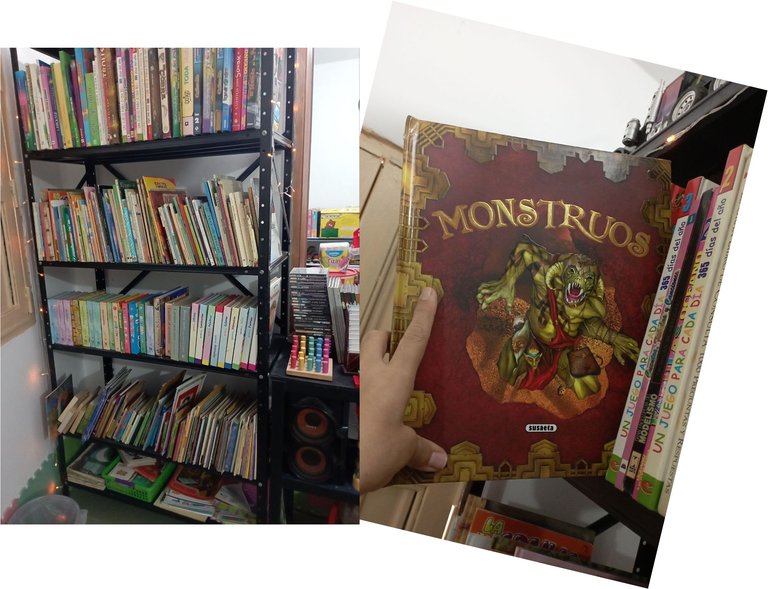
Contar un cuento a un niño con autismo es contar un cuento a un niño…
Autismo Diario
Aunque sabemos que pudiera haber algunas diferencias, como se puede leer en el artículo, pienso que la esencia de esta cita está en que, más que limitarnos por lo que conocemos sobre las características cognitivas y conductuales del niño autista, miremos con curiosidad pedagógica las posibilidades.
Es necesario que en el espacio de atención psicopedagógico se encuentren disponibles una variedad de materiales, e incluso, que en el transcurso del tiempo se vayan adquiriendo nuevos. Se requiere de la mayor cantidad y variedad de medios para mediar los procesos de aprendizaje; pero no sólo eso. Los niños autistas, por la alta variabilidad de interferencias, necesitan que la estimulación llegue por las diferentes modalidades sensoriales.
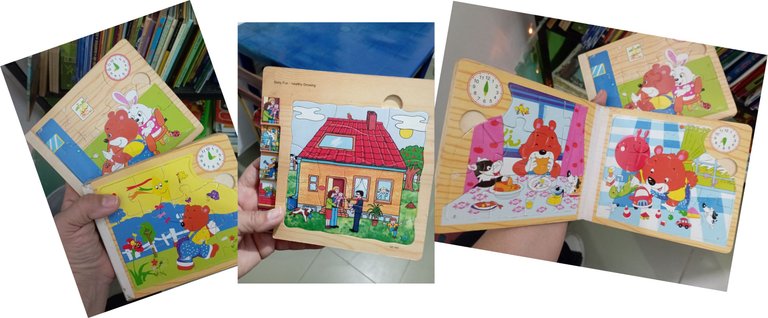
Cuentos de madera
No se piense que se trata de un abordaje ecléctico. En general cuando un niño presenta dificultades para organizar sus aprendizajes, la organización, el orden, la secuencia y sobre todo la pertinencia, tanto en el proceso de evaluación como en el proceso de atención psicopedagógica, es muy importante la coherencia de los vínculos entre los objetivos, las estrategias y los materiales.
Por otra parte, es paradigmática la dificultad marcada de los niños con TEA para entender el lenguaje figurado, es decir, el niño con TEA muestra una tendencia a procesar el significado composicional de la oración y a ignorar la intención comunicativa que subyace en la preferencia del enunciado, por lo que estos sujetos presentan problemas con este tipo de lenguaje, ya que este es interpretado literalmente (Happé, 1993, 1994, 1997; Happe & Frith, 1991; Jolliffe & Baron-Cohen, 1999, 2000; MacKay & Shaw, 2004; Tager-Flusberg, Paul & Lord, 2005)
El lenguaje no literal en niños con TEA: Los efectos de la frecuencia y de la Teoría de la Mente en las metáforas y las ICG
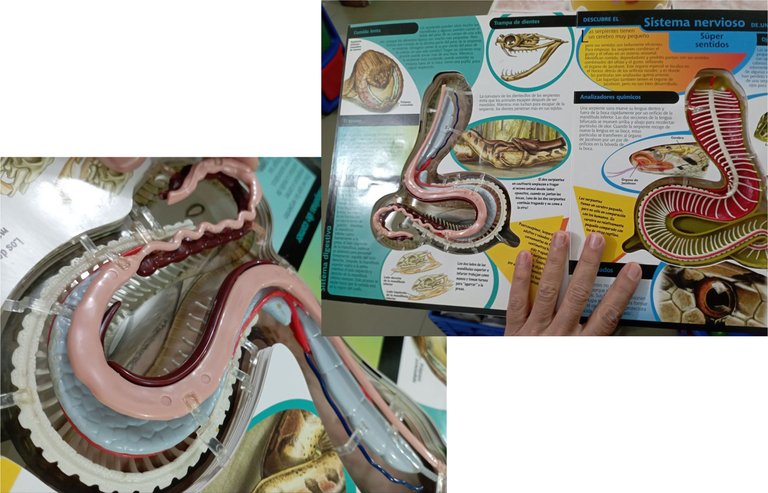
Cuentos de relieve
Sabemos que los niños autistas tienen debilidades metarepresentativas y que les es muy difícil captar el lenguaje que no es claro y donde sus significados no están plenamente expuestos. También sabemos que el espectro autista tiene niveles de severidad, que pueden ir desde leve hasta severos, pasando por un nivel intermedio, que se señala como moderado. Estos niveles dependen de qué tan consistentes sean los niveles de ayuda.
Para mayor información consulta: Dsm5
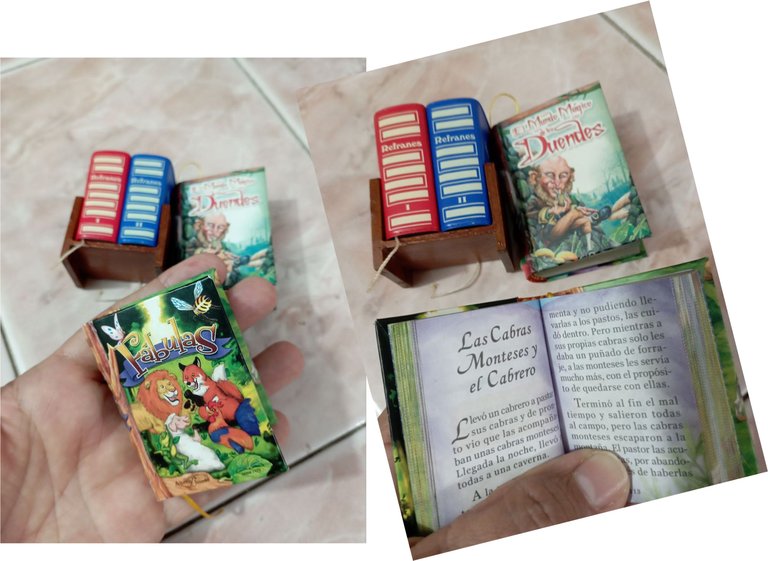
Cuentos miniatura.
El cuento es un recurso que le añade un valor agregado a la terapia psicopedagógica. Su utilización con niños en el espectro autista debe ser muy consciente en el sentido que se debe tener cuidado qué tipo de texto que se utilice. Por ejemplo, para algunos niños autistas no utilizo poesías, ni adivinanzas, chistes, ni textos donde se tenga que trabajar con muchos elementos poéticos como símiles o metáforas. Sin embargo, es igualmente importante no privar, previo conocimiento del niño con el que se trabaja, del cuento.
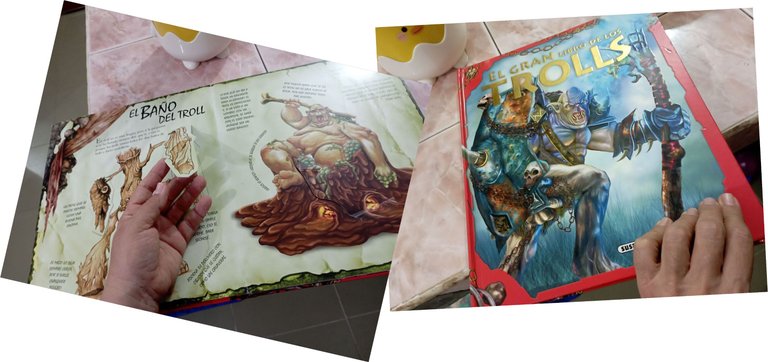
Cuentos de gran tamaño, en relieve y con pistas secretas
El cuento es un recurso muy valioso que depende de una diversidad de factores para su uso, entre ellas la habilidad del terapeuta. Es importante saber y conocer las características cognitivas de lo niño autistas y también es importante que se mantenga hacia el conocimiento una visión amplia y ponderada de lo que conocemos hasta el momento, de los cambios que podemos influenciar, de sobre todos de las capacidades reales del niño y de las que podría desarrollar si se realiza una intervención adecuada.
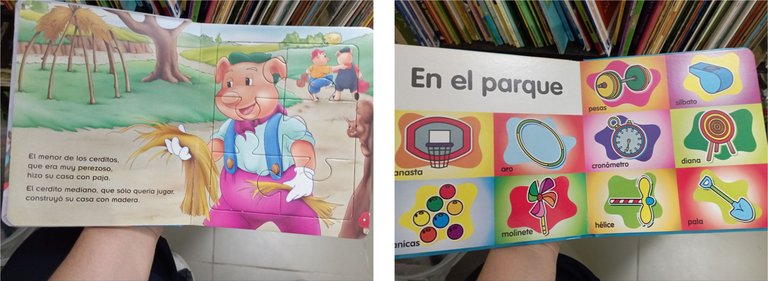
Cuentos con rompecabezas y material duro y resistente.
Como todo objeto de conocimiento, el cuento debe ser manipulado, observado y aprehendido por el niño. Se debe permitir que aplique todos sus esquemas de acción e interacción sobre él, a partir de ahí vamos a conocer una valiosa fuente de información que nos va a permitir ajustar nuestros propósitos.
El niño abre el cuento y luego lo desecha, no le interesa, señala las ilustraciones, pide que lo leas, te pregunta ¿qué dice aquí?, lo rompe, lo hojea hasta el final, lo lee, lo lanza, lo pisa, lo muerde, nombra las ilustraciones, cuando lo lees te pregunta dónde está lo que dices porque no lo mira en los dibujos, pregunta cómo se llama el cuento, se emociona o le aburre cuando lees, se interesa y le atrae... en fin, podrían haber cientos de posible conductas.
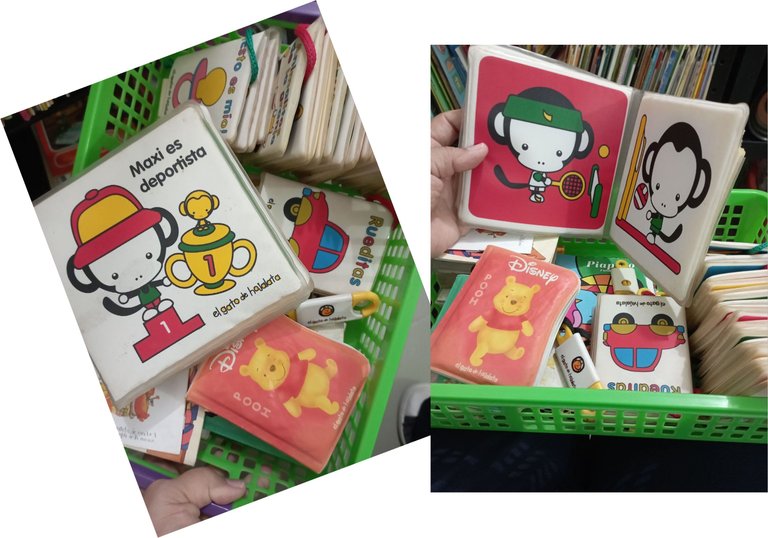
Cuentos protegidos que se pueden mojar.
Lo que corresponde es que seamos buenos observadores y a partir de la información obtenida iniciar un trabajo minucioso de estimulación hacia el cuento. A través del tiempo los aspectos que he tenido en cuenta para iniciar el trabajo pedagógico para este acercamiento son: la edad del niño, su potencial cognitivo, el grado de autismo, nivel de lenguaje y su experiencia con la convivencia y manipulación de material escrito diverso (aspectos mencionados en el párrafo anterior).
Les menciono que también los cuentos tienen características para cada necesidad, los hay de tela, de hule, de plástico, de cartón, de madera, grandes, muy grandes, pequeños, muy pequeños, de papel, con sonidos, de texturas, con rompecabezas, con figuras para pegar, de relieves,…en fin, todo un mundo de posibilidades.
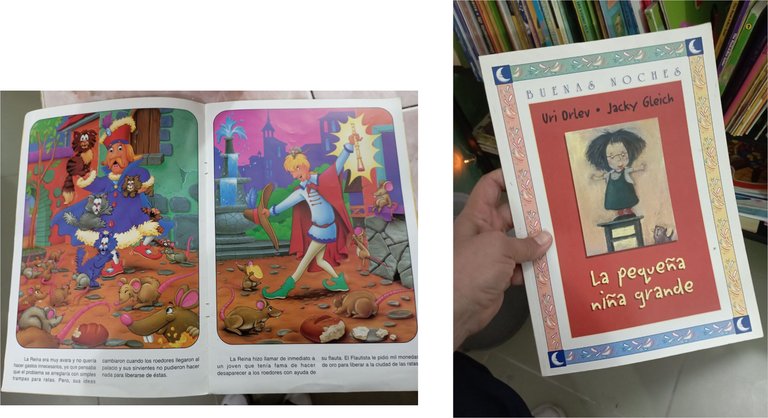
Cuentos en formato grande, tipo cartillas, y muy coloridos.
Como correlato, pienso que es importante que cada niño, a su nivel y preferencias, tenga la oportunidad de relacionarse con cuentos. Realmente no sabemos hasta qué punto estamos tocando centros de interés cognitivos, afectivos y emocionales que brinden a los niños autistas oportunidades de potenciar nuevos aprendizajes.
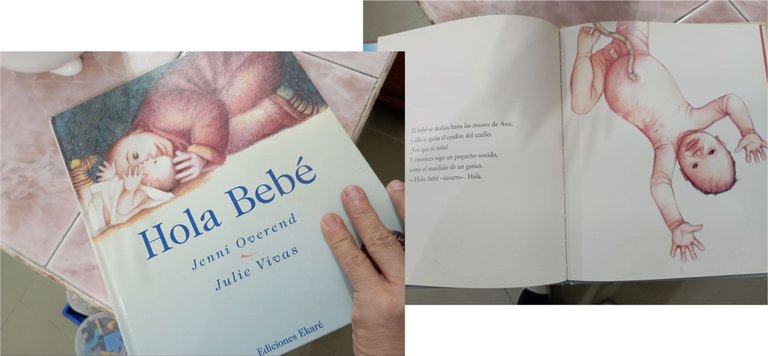
Cuentos sobre hechos de la vida.
Todas las fotografía las he tomado con mi teléfono Redmi11 y son cuentos de mi biblioteca personal de literatura infantil. Editadas en el programa PowerPoint.
La traducción la he realizado con Google.

Soy Sandra Cabrera, licenciada en Dificultades para el Aprendizaje, con estudios de postgrado en Educación Especial Integral, Planificación Educativa y Literatura Infantil. Si te interesan los temas sobre educación especial, la discapacidad y las condiciones especiales del desarrollo, puedes contactarme a través de los números 04128032993 y 0412 8333334 y en:
El canal de Telegram, Trastornos del Aprendizaje.
En las redes sociales Instagram y Facebook1 y Facebook2. Sandra Cabrera Psicopedagoga.
En la cuenta de spreaker, @sandracabrerapodcast.
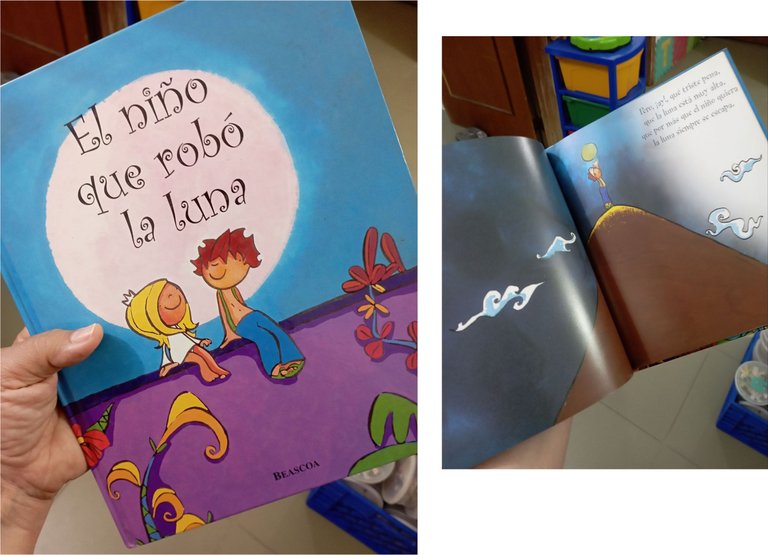

Telling a story to a child with autism is telling a story to a child…
Autismo Diario
Although we know that there could be some differences, as you can read in the article, I think that the essence of this quote is that, rather than limiting ourselves by what we know about the cognitive and behavioral characteristics of the autistic child, we look with pedagogical curiosity at the possibilities.
It is necessary that a variety of materials are available in the psychopedagogical care space, and even that new ones are acquired over time. The greatest quantity and variety of means is required to mediate the learning processes; but not only that. Autistic children, due to the high variability of interference, need stimulation to come through different sensory modalities.

Wooden tales
Do not think that this is an eclectic approach. In general, when a child has difficulties organizing his or her learning, the organization, order, sequence and above all the relevance, both in the evaluation process and in the psychopedagogical care process, the coherence of the links between the objectives, strategies and materials is very important. #
On the other hand, the marked difficulty of children with ASD to understand figurative language is paradigmatic, that is, the child with ASD shows a tendency to process the compositional meaning of the sentence and to ignore the communicative intention that underlies the preference of the statement, so these subjects have problems with this type of language, since it is interpreted literally (Happé, 1993, 1994, 1997; Happe & Frith, 1991; Jolliffe & Baron-Cohen, 1999, 2000; MacKay & Shaw, 2004; Tager-Flusberg, Paul & Lord, 2005)
Non-literal language in children with ASD: The effects of frequency and Theory of Mind on metaphors and ICG

Stories of relief
We know that autistic children have metarepresentational weaknesses and that it is very difficult for them to grasp language that is not clear and where its meanings are not fully exposed. We also know that the autistic spectrum has levels of severity, which can range from mild to severe, passing through an intermediate level, which is indicated as moderate. These levels depend on how consistent the levels of help are.
For more information, see: Dsm5

Miniature stories.
The story is a resource that adds value to psychopedagogical therapy. Its use with children on the autism spectrum must be very conscious in the sense that care must be taken with what type of text is used. For example, for some autistic children I do not use poems, riddles, jokes, or texts where you have to work with many poetic elements such as similes or metaphors. However, it is equally important not to deprive the child you are working with of the story, after having previously known it.

Large-sized stories, in relief and with secret clues
The story is a very valuable resource that depends on a variety of factors for its use, including the skill of the therapist. It is important to know and understand the cognitive characteristics of autistic children and it is also important to maintain a broad and balanced view of what we know so far, of the changes that we can influence, above all of the child's real abilities and those that could be developed if an appropriate intervention is carried out.

Stories with puzzles and hard and resistant material.
Like any object of knowledge, the story must be manipulated, observed and learned by the child. He must be allowed to apply all his action and interaction schemes to it, and from there we will discover a valuable source of information that will allow us to adjust our purposes.
The child opens the story and then throws it away, he is not interested, he points to the illustrations, asks you to read it, asks you what does it say here?, tears it up, flips through it to the end, reads it, throws it, steps on it, bites it, names the illustrations, when you read it he asks you where what you say is because he doesn't look at the pictures, asks what the story is called, gets excited or bored when you read, is interested and attracted to it... in short, there could be hundreds of possible behaviors.

Protected stories that can get wet.
What is appropriate is that we be good observers and based on the information obtained, start a thorough work of stimulation towards the story. Over time, the aspects that I have taken into account to start the pedagogical work for this approach are: the age of the child, his cognitive potential, the degree of autism, language level and his experience with the coexistence and manipulation of diverse written material (aspects mentioned in the previous paragraph).
I mention that stories also have characteristics for each need, there are ones made of cloth, rubber, plastic, cardboard, wood, large, very large, small, very small, paper, with sounds, textures, puzzles, figures to stick, reliefs, ... in short, a whole world of possibilities.

Large format stories, like booklets, and very colorful.
As a corollary, I think it is important that each child, at their level and preferences, has the opportunity to relate to stories. We really do not know to what extent we are touching cognitive, affective and emotional centers of interest that provide autistic children with opportunities to enhance new learning. #

Stories about real-life events.
All the photos were taken with my Redmi11 phone and are stories from my personal library of children's literature.
I have translated it with Google.

I am Sandra Cabrera, a graduate in Learning Difficulties, with postgraduate studies in Comprehensive Special Education, Educational Planning and Children's Literature. If you are interested in topics related to special education, disability and special developmental conditions, you can contact me at 04128032993 and 0412 8333334 and at:
The Telegram channel, Learning Disorders.
On social media Instagram and Facebook1 and Facebook2. Sandra Cabrera Psychopedagogue.
On spreaker account, @sandracabrerapodcast. # 
Otra excelente estrategia que trae consigo posibilidades de desarrollo y de cambios positivos en nuestros niños!
Gracias una vez más @sandracabrera.
¡Bienvenidas las Delegaciones / Welcome Delegations
Trail de Curación / Curation Trail
@tipu curate 8
Upvoted 👌 (Mana: 0/75) Liquid rewards.
Hola @sandracabrera. Está muy conveniente tu publicación, en todos los sentidos. Especialmente porque pienso en que es importante que el niño toque el libro de cuento, se sienta cerca de él, lo manipule y hasta lo huela. Digo esto porque ahora, por la modernidad, existen muchas App para todo, lo que veo muy negativo. Pero ese es otro tema.
Muchas gracias por tu contenido y un abrazo 💙
Hola. Muy cierto.
Para todo ser humano es irremplazable el contacto humano, el material escrito y tangible...para un niño...más que indispensable...para un niño autista, indispensable y necesario.
Gracias por tu visita.